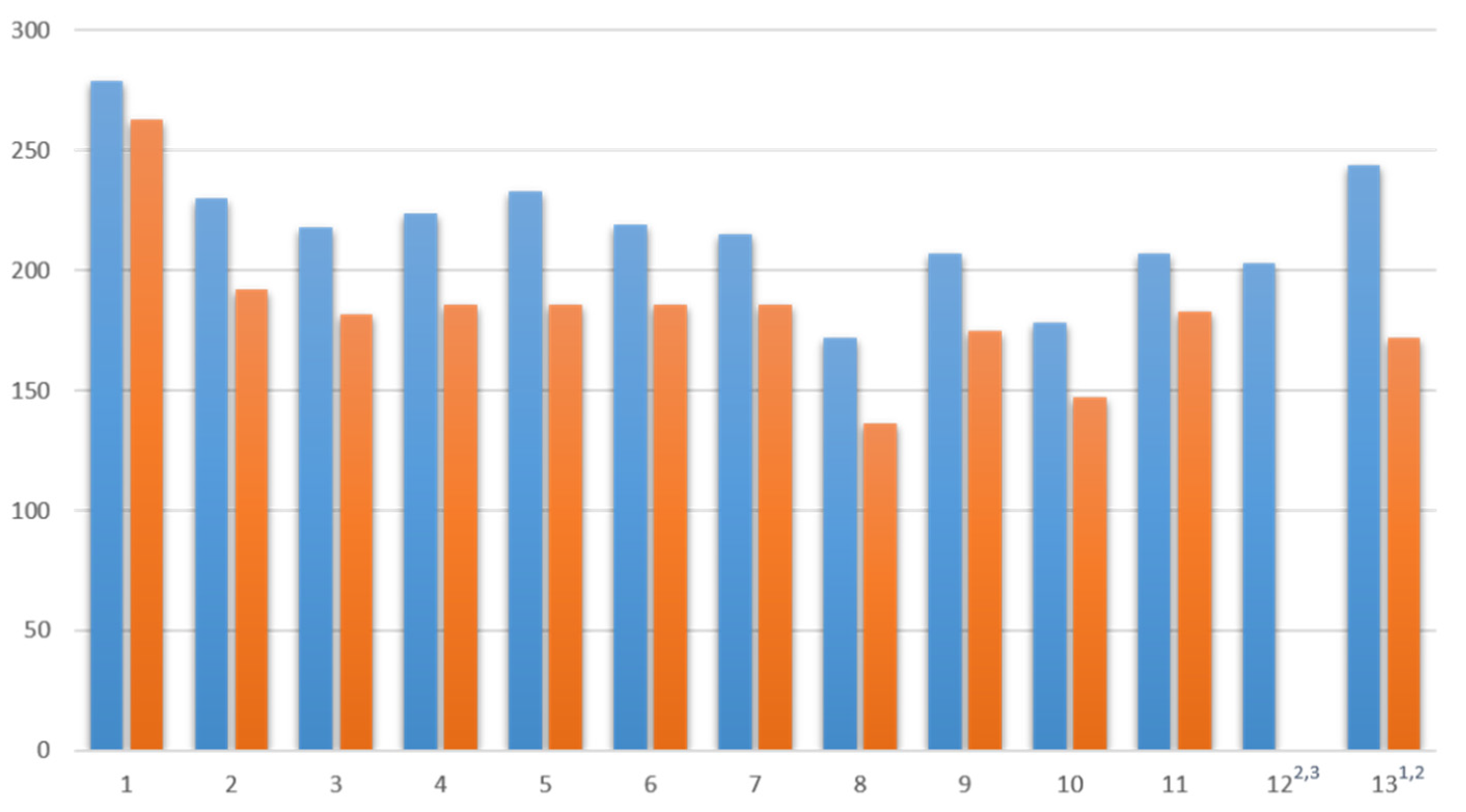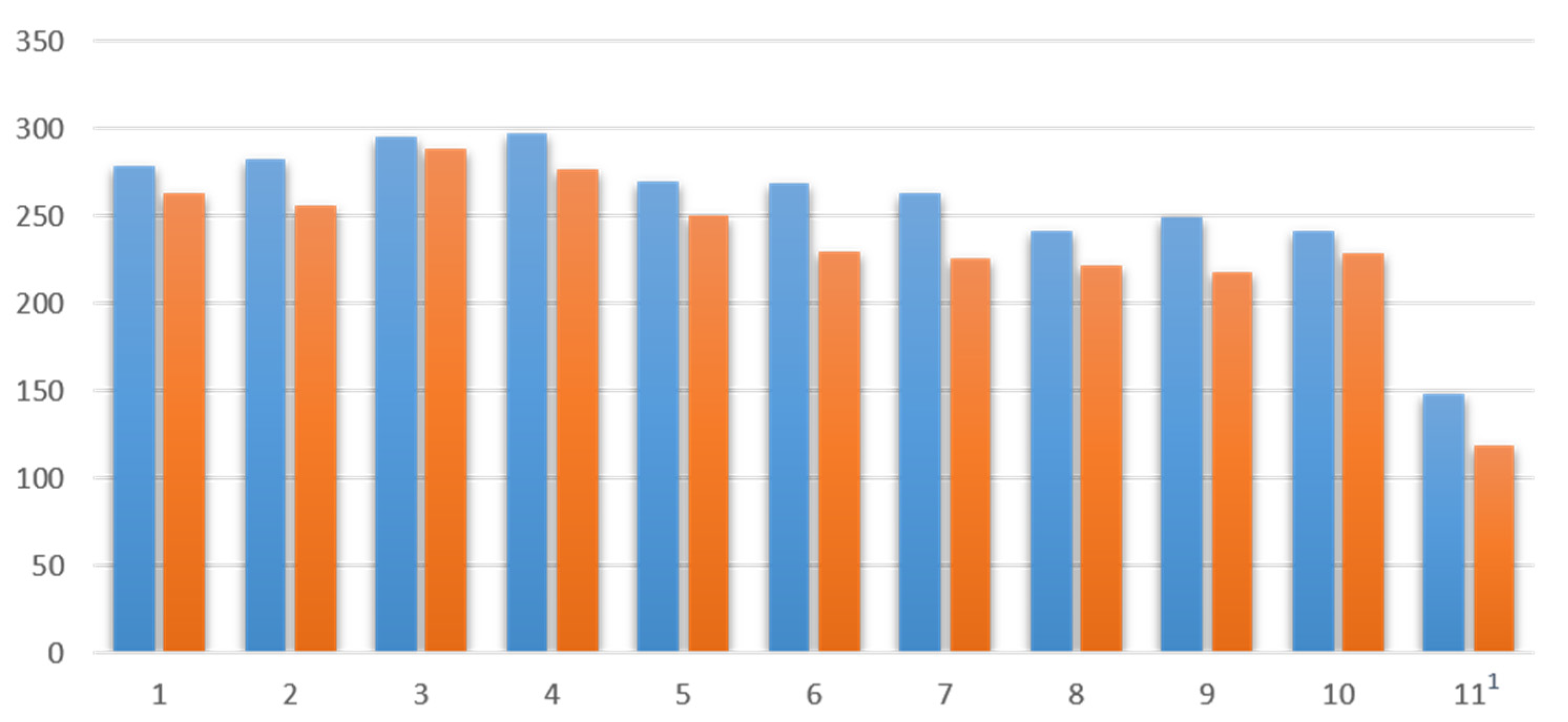Virtual Classrooms and Their Challenge of Interaction—An Evaluation of Chat Activities and Logs in an Online Course about Digital Medicine with Heterogeneous Participants
Abstract
:1. Introduction
- Can different forms of (meaningful) interaction take place in an online course of this size?
- What interaction rate can be achieved in an online course through simple and continuous interaction elements?
2. Materials and Methods
2.1. Intervention
2.2. Participants
2.3. Data Collection
2.4. Data Analysis
3. Results
4. Discussion
5. Conclusions
Author Contributions
Funding
Institutional Review Board Statement
Informed Consent Statement
Data Availability Statement
Conflicts of Interest
References
- Neumann, M.; Fehring, L.; Kinscher, K.; Truebel, H.; Dahlhausen, F.; Ehlers, J.P.; Mondritzki, T.; Boehme, P. Perspective of German medical faculties on digitization in the healthcare sector and its influence on the curriculum. GMS J. Med. Educ. 2021, 38, Doc124. [Google Scholar] [CrossRef]
- Kuhn, S.; Frankenhauser, S.; Tolks, D. Digitale Lehr- und Lernangebote in der medizinischen Ausbildung: Schon am Ziel oder noch am Anfang? Bundesgesundheitsbl 2018, 61, 201–209. [Google Scholar] [CrossRef]
- Santos, A.I.; Serpa, S. The Importance of Promoting Digital Literacy in Higher Education. Int. J. Soc. Sci. Stud. 2017, 5, 90. [Google Scholar] [CrossRef]
- Bundesministerium für Bildung und Forschung—BMBF. “Masterplan Medizinstudium 2020”. Available online: https://www.bmbf.de/bmbf/shareddocs/kurzmeldungen/de/masterplan-medizinstudium-2020.html (accessed on 2 July 2022).
- MFT Medizinischer Fakultätentag der Bundesrepublik Deutschland e. V. Nationaler Kompetenzbasierter Lernzielkatalog Medizin (NKLM). Available online: https://medizinische-fakultaeten.de/wp-content/uploads/2021/06/nklm_final_2015-12-04.pdf (accessed on 2 July 2022).
- Bond, M.; Buntins, K.; Bedenlier, S.; Zawacki-Richter, O.; Kerres, M. Mapping research in student engagement and educational technology in higher education: A systematic evidence map. Int. J. Educ. Technol. High. Educ. 2020, 17, 2. [Google Scholar] [CrossRef]
- Kuhn, S.; Kadioglu, D.; Deutsch, K.; Michl, S. Data Literacy in der Medizin. Onkologe 2018, 24, 368–377. [Google Scholar] [CrossRef]
- Kuhn, S.; Ammann, D.; Cichon, I.; Ehlers, J.; Guttormsen, S.; Hülsken-Giesler, M.; Kaap-Fröhlich, S.; Kickbusch, I.; Pelikan, J.; Reber, K.; et al. Wie Revolutioniert die Digitale Transformation die Bildung der Berufe im Gesundheitswesen? Careum Stiftung: Zurich, Switzerland, 2019; ISBN 978-3-03787-969-6. [Google Scholar]
- Nitsche, J.; Smetana, J.; Kochanek, T.; Busse, T.S.; Kernebeck, S.; Taetz-Harrer, A.; Zupanic, M.; Eulitz, M.; Ehlers, J. Needs must when the devil drives—Migration of an entire university to digital teaching. ZFHE 2021, 16, 161–180. [Google Scholar] [CrossRef]
- Hodges, C.B.; Moore, S.; Lockee, B.B.; Trust, T.; Bond, M.A. The Difference between Emergency Remote Teaching and Online Learning. 2020. Available online: https://er.educause.edu/articles/2020/3/the-difference-between-emergency-remote-teaching-and-online-learning (accessed on 30 June 2022).
- Zimmerman, J. Coronavirus and the Great Online-Learning Experiment. The Chronicle of Higher Education. 10 March 2020. Available online: https://www.chronicle.com/article/coronavirus-and-the-great-online-learning-experiment/ (accessed on 2 July 2022).
- Bär, H.; Häussge, G.; Rößling, G. An integrated system for interaction support in lectures. SIGCSE Bull. 2007, 39, 281–285. [Google Scholar] [CrossRef]
- Lehmann, K.; Söllner, M. Theory-Driven Design of a Mobile-Learning Application to Support Different Interaction Types in Large-Scale Lectures. In Proceedings of the European Conference on Information Systems, Tel Aviv, Israel, 9–11 June 2014. [Google Scholar] [CrossRef]
- van der Keylen, P.; Lippert, N.; Kunisch, R.; Kühlein, T.; Roos, M. Asynchronous, digital teaching in times of COVID-19: A teaching example from general practice. GMS J. Med. Educ. 2020, 37, Doc98. [Google Scholar] [CrossRef]
- Chi, M.T.H.; Wylie, R. The ICAP Framework: Linking Cognitive Engagement to Active Learning Outcomes. Educ. Psychol. 2014, 49, 219–243. [Google Scholar] [CrossRef]
- Camiciottoli, B.C. Interaction in academic lectures vs. written text materials: The case of questions. J. Pragmat. 2008, 40, 1216–1231. [Google Scholar]
- Bakonyi, V.; Illes, Z.; Verma, C. Virtual classrooms and real-time interactivity. In Proceedings of the 2021 2nd International Conference on Intelligent Engineering and Management (ICIEM), London, UK, 28–30 April 2021; pp. 69–74. [Google Scholar]
- Manou, E.; Lazari, E.-C.; Thomopoulou, G.-E.; Agrogiannis, G.; Kavantzas, N.; Lazaris, A.C. Participation and Interactivity in Synchronous E-Learning Pathology Course during the COVID-19 Pandemic. Adv. Med. Educ. Pract. 2021, 12, 1081–1091. [Google Scholar] [CrossRef]
- Khamidov, O.A. Theory and practice of introducing active and interactive forms of training in vocational education. Eur. J. Res. Reflect. Educ. Sci. 2019, 7, 109–114. [Google Scholar]
- Cook, D.A.; Levinson, A.J.; Garside, S.; Dupras, D.M.; Erwin, P.J.; Montori, V.M. Internet-based learning in the health professions: A meta-analysis. JAMA 2008, 300, 1181–1196. [Google Scholar] [CrossRef]
- Ehlers, J.P.; Herrmann, M.; Mondritzki, T.; Truebel, H.; Boehme, P. Digital transformation of medicine—Experiences with a course to prepare students to seize opportunities and minimize risks. GMS Med. Inform. Biom. Epidemiol. 2019, 15, Doc06. [Google Scholar] [CrossRef]
- Offergeld, C.; Neudert, M.; Emerich, M.; Schmidt, T.; Kuhn, S.; Giesler, M. Vermittlung digitaler Kompetenzen in der curricularen HNO-Lehre: Abwartende Haltung oder vorauseilender Gehorsam? HNO 2020, 68, 257–262. [Google Scholar] [CrossRef]
- Kuckartz, U. Qualitative Inhaltsanalyse: Methoden, Praxis, Computerunterstützung, 3. überarbeitete Auflage; Beltz Juventa: Weinheim, Germany, 2016; ISBN 3779933446. [Google Scholar]
- Asad, M.M.; Hussain, N.; Wadho, M.; Khand, Z.H.; Churi, P.P. Integration of e-learning technologies for interactive teaching and learning process: An empirical study on higher education institutes of Pakistan. J. Appl. Res. High. Educ. 2020, 13, 649–663. [Google Scholar]
- Altintas, L.; Altintas, O.; Caglar, Y. Modified use of team-based learning in an ophthalmology course for fifth-year medical students. Adv. Physiol. Educ. 2014, 38, 46–48. [Google Scholar] [CrossRef]
- Banovac, I.; Katavić, V.; Blažević, A.; Bičanić, I.; Hladnik, A.; Kovačić, N.; Petanjek, Z. The anatomy lesson of the SARS-CoV-2 pandemic: Irreplaceable tradition (cadaver work) and new didactics of digital technology. Croat. Med. J. 2021, 62, 173–186. [Google Scholar] [CrossRef]
- Giesbers, B.; Rienties, B.; Tempelaar, D.; Gijselaers, W. A dynamic analysis of the interplay between asynchronous and synchronous communication in online learning: The impact of motivation. J. Comput. Assist. Learn. 2014, 30, 30–50. [Google Scholar] [CrossRef]
- Handschuh, K. Videosprechstunden: Nur jeder zehnte Arzt sieht Potenzial für die eigene Praxis. DNP 2022, 23, 57. [Google Scholar] [CrossRef]
- Fölsch, U.R.; Ertl, G. Facharzt-Training Innere Medizin—Das fünfte Sonderheft ist da!: Fallbezogenes Lernen anhand der neuen Muster-Weiterbildungsordnung. Internist 2022, 63, 1–3. [Google Scholar] [CrossRef]
- Bartrum, P. The Impact of Interactive Technology on the Future of School Education. Available online: https://mdreducation.com/2018/05/22/interactive-technology-education/ (accessed on 2 July 2022).
- Porter, A.G.; Tousman, S. Evaluating the effect of interactive audience response systems on the perceived learning experience of nursing students. J. Nurs. Educ. 2010, 49, 523–527. [Google Scholar] [CrossRef]
- Sindiani, A.M.; Obeidat, N.; Alshdaifat, E.; Elsalem, L.; Alwani, M.M.; Rawashdeh, H.; Fares, A.S.; Alalawne, T.; Tawalbeh, L.I. Distance education during the COVID-19 outbreak: A cross-sectional study among medical students in North of Jordan. Ann. Med. Surg. 2020, 59, 186–194. [Google Scholar] [CrossRef]
- Beatty, I.D.; Gerace, W.J.; Leonard, W.J.; Dufresne, R.J. Designing effective questions for classroom response system teaching. Am. J. Phys. 2006, 74, 31–39. [Google Scholar] [CrossRef]
- Pohl, A. Fostering Awareness and Collaboration in Large-Class Lectures; Lmu, Ludwig-Maximilians-Universität München: München, Germany, 2015. [Google Scholar]
- Richardson, M.L.; Shaffer, K.; Amini, B.; Spittler, N.L.J. Advanced, Interactive, Image-based Education: Technology and Pedagogy. Curr. Probl. Diagn. Radiol. 2020, 49, 74–81. [Google Scholar] [CrossRef]


| Session | Topic | |
|---|---|---|
| Winter Term 2019/2020 | Summer Term 2020 | |
| 1 | Introduction Digital Medicine | Introduction Digital Medicine |
| 2 | Artificial Intelligence | COVID-19 |
| 3 | Project presentation XPOMET | Care robotics |
| 4 | Homo digitus | E-learning |
| 5 | Digital insulin pump and Ivena | Online psychotherapy |
| 6 | Social Media and learning with webinar | Apps in medical sector |
| 7 | Project presentation Chatbots@FOAMed | Digital processes in medicine |
| 8 | Electronic medical records | Homo digitus |
| 9 | Project presentation da Vinci | Virtual reality in medicine |
| 10 | Project presentation Biotronik | Digitization in pharmacy |
| 11 | eHealth Literacy | Site Visit 1 |
| 12 2,3 | Data protection in medical practice | |
| 13 2 | FutureMedTalk 1 | |
| Categories | Description | Sample Quotes |
|---|---|---|
| Social interaction | This category includes statements that promote a purely social exchange, whether among the participants or even with the presenters, but make no substantive contribution to the topic under discussion. | “Good Evening”, “Sorry that I’m late” |
| Technical interaction | This category includes statements dealing with technical problems or suggestions related to the functioning of the platform itself. It does not include statements that revolve around technical content in the session. | “I have problems with the internet connection” |
| Interaction on topic | This category includes statements that relate to the topic of the session, either as questions or as comments. It does not include statements that are, for example, thanks to the presenter (social interaction). | “A nurse could make house calls with a digitally connected doctor” |
| Winter Term 2019/2020 | Summer Term 2020 | |||||
|---|---|---|---|---|---|---|
| Date | Social Interaction (%) | Technical Interaction (%) | Interaction on Topic (%) | Social Interaction (%) | Technical Interaction (%) | Interaction on Topic (%) |
| 1 | 64.30 | 17.62 | 18.54 | 36.54 | 18.63 | 44.93 |
| 2 | 64.05 | 14.15 | 23.71 | 19.37 | 8.27 | 72.36 |
| 3 | 54.64 | 10.93 | 34.77 | 28.39 | 3.24 | 68.18 |
| 4 | 79.90 | 16.95 | 3.15 | 30.55 | 3.56 | 66.21 |
| 5 | 75.84 | 15.34 | 8.40 | 53.79 | 5.40 | 40.80 |
| 6 | 57.34 | 9.44 | 33.39 | 57.38 | 1.82 | 40.98 |
| 7 | 58.58 | 15.12 | 26.16 | 92.86 | 5.36 | 4.02 |
| 8 | 82.15 | 10.46 | 7.38 | 47.83 | 4.23 | 48.16 |
| 9 | 58.86 | 20.23 | 20.90 | 64.34 | 3.49 | 32.17 |
| 10 | 84.64 | 9.34 | 6.02 | 36.88 | 2.81 | 60.42 |
| 11 | 45.28 | 8.92 | 45.98 | 55.13 1 | 4.40 1 | 40.47 1 |
| 12 2 | n.n 3 | n.n. 3 | n.n. 3 | |||
| 13 2 | 68.96 1 | 7.42 1 | 23.63 1 | |||
| Ø of all dates | 63.2 | 13 | 23.8 | 40.77 | 5.71 | 53.69 |
Publisher’s Note: MDPI stays neutral with regard to jurisdictional claims in published maps and institutional affiliations. |
© 2022 by the authors. Licensee MDPI, Basel, Switzerland. This article is an open access article distributed under the terms and conditions of the Creative Commons Attribution (CC BY) license (https://creativecommons.org/licenses/by/4.0/).
Share and Cite
Nitsche, J.; Busse, T.S.; Kernebeck, S.; Ehlers, J.P. Virtual Classrooms and Their Challenge of Interaction—An Evaluation of Chat Activities and Logs in an Online Course about Digital Medicine with Heterogeneous Participants. Int. J. Environ. Res. Public Health 2022, 19, 10184. https://doi.org/10.3390/ijerph191610184
Nitsche J, Busse TS, Kernebeck S, Ehlers JP. Virtual Classrooms and Their Challenge of Interaction—An Evaluation of Chat Activities and Logs in an Online Course about Digital Medicine with Heterogeneous Participants. International Journal of Environmental Research and Public Health. 2022; 19(16):10184. https://doi.org/10.3390/ijerph191610184
Chicago/Turabian StyleNitsche, Julia, Theresa Sophie Busse, Sven Kernebeck, and Jan P. Ehlers. 2022. "Virtual Classrooms and Their Challenge of Interaction—An Evaluation of Chat Activities and Logs in an Online Course about Digital Medicine with Heterogeneous Participants" International Journal of Environmental Research and Public Health 19, no. 16: 10184. https://doi.org/10.3390/ijerph191610184
APA StyleNitsche, J., Busse, T. S., Kernebeck, S., & Ehlers, J. P. (2022). Virtual Classrooms and Their Challenge of Interaction—An Evaluation of Chat Activities and Logs in an Online Course about Digital Medicine with Heterogeneous Participants. International Journal of Environmental Research and Public Health, 19(16), 10184. https://doi.org/10.3390/ijerph191610184








